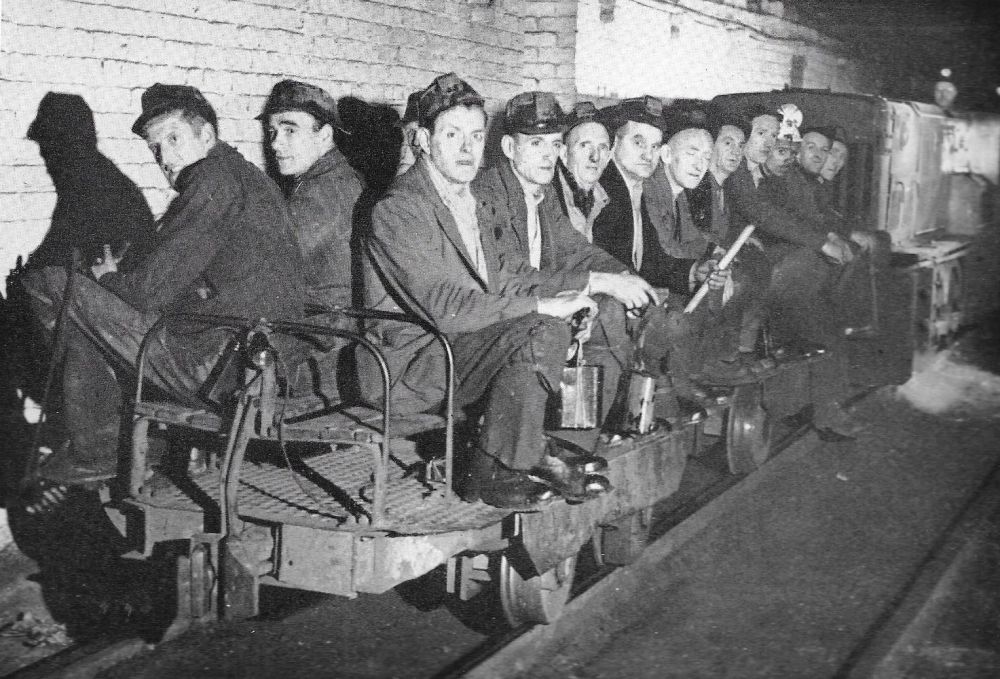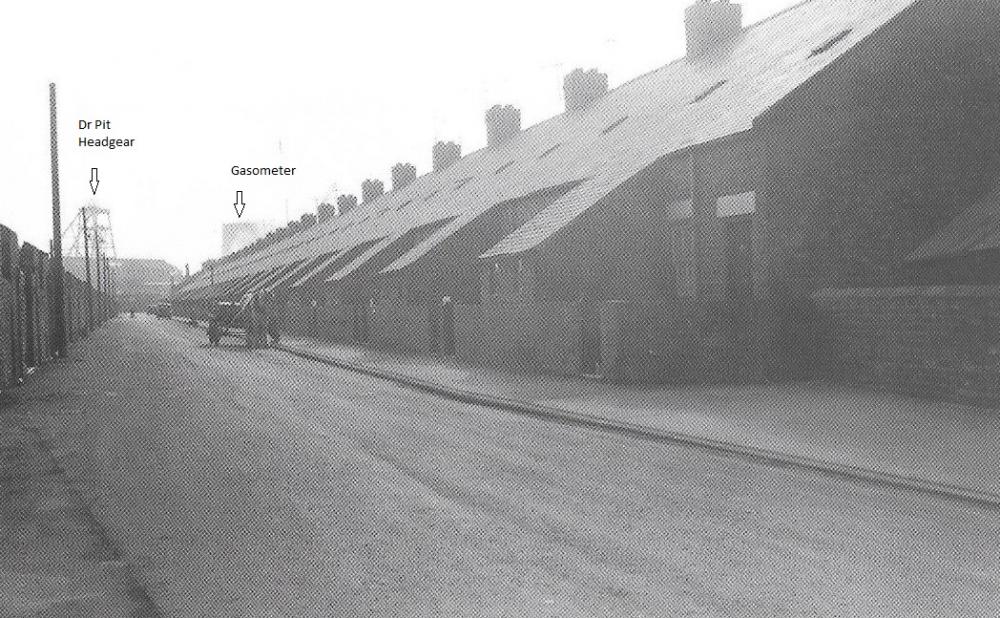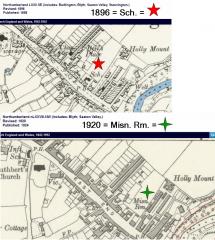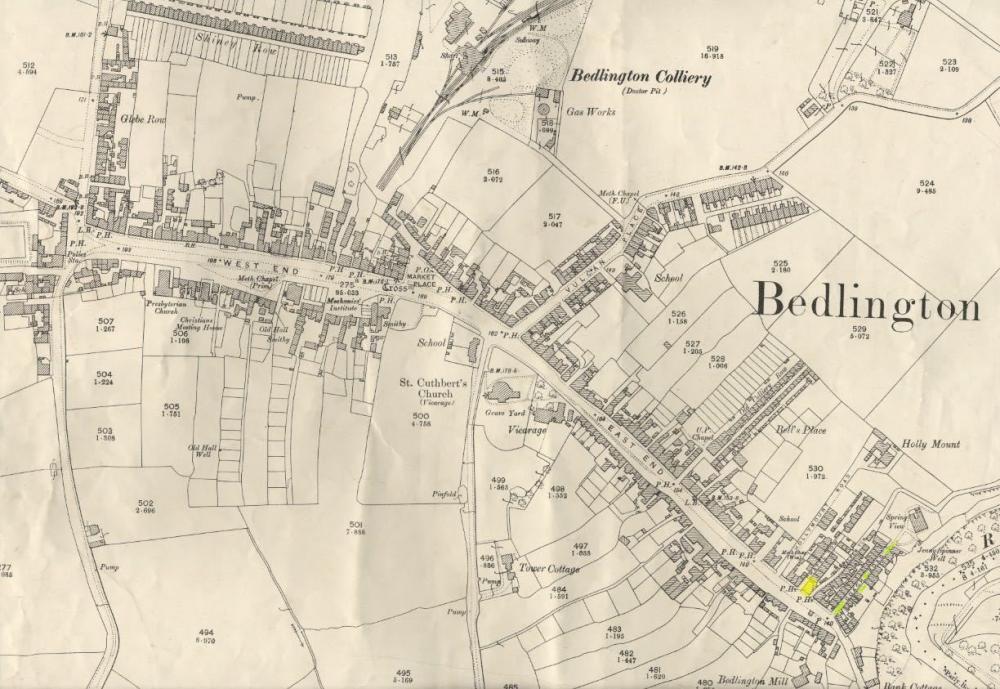
James
Members-
Posts
210 -
Joined
-
Last visited
-
Days Won
51
Content Type
Forums
Gallery
Events
Shop
News
Audio Archive
Timeline
Everything posted by James
-
I've attached a photo of a "man riding set" at Bates Colliery taken around 1955 before the modernisation of the colliery.
-
The photo supposedly showing the shirt factory was taken at the “back” of Shiney Row. Between the bottom and Shiney Row and the gasometer was the surface infrastructure of the Doctor Pit – rail sidings, timber yard, workshops, heapstead, offices etc. What is shown as the Shirt Factory was one of the Dr Pit offices, probably the Planned Maintenance office. The shirt factory was at the top end of Bedlington roughly where the library is now. There used to be a footpath from Shiney Row to the front street, exiting near the Bluebell pub. The entrance to the shirt factory was from this footpath. My photo was taken from Glebe Road looking toward the Dr Pit.
-
Maps showing 'Sch.' then 'Misn.Rm.'
James commented on Alan Edgar (Eggy1948)'s gallery image in Historic Bedlington
I have attached information about the school from Stephen Martin's book titled "Bedlington". In this book he states that in 1886 it was called The East School (Mixed)and the head was George Whittle. the second attachment is from "A Thousand Years in Bedlington Church ..." which states the East School closed around 1901. I assume that the second map of 1920, showing Misn. Rm. indicates that the school buildings were then used as a Mission Room or Hall. (Misn. Rm. = mission room.) I'm guessing! The East End.pdf East End School 2.pdf -
Westridge - End of term class photos
James replied to Alan Edgar (Eggy1948)'s topic in History Hollow
No 13 is Bobby Cross. After completing his GCE, he studied at the Royal Academy of Dramatic Art and was in a few movies. -
579cc6ff9babe-Whitley-Memorial-1956-7Footballteamnamed.jpg
James commented on Alan Edgar (Eggy1948)'s gallery image in Historic Bedlington
Whitley Memorial 1956-57 football team. Correct names are 1. Richard Mitcheson, 2. John Hale. 3. Brian Richmond. 4. David Wood. 5. George Musgrave. 6. Ian Nesbit. 7. Alan Wilkinson. 8. Ronald Leyland. 9. Michael Rutherford. 10. Michael Bradley. 11. Peter Tighe. 12. Matt Hall This was the last senior team. At the end of the 1956/57 school year, Westridge school opened and from that date the Whitley was a junior school only. -
Coach Road is shown in green in the bottom right hand corner of the attached 1897 ordinance plan. The Jonnie Johnson retirement home is shown in yellow
-
Bedlington has officially recognised the significant contributions made to the community of certain individuals such as Dr Brown. History is obviously important and no one has done more than the late Evan Martin to preserve the past through his books and he has left a permanent record of Bedlingtonshire covering a period when it was part of a vibrant industrial region, now gone forever. I think we can count ourselves lucky that someone with a deep interest in the town was prepared to put in so much effort collecting stories and photos and publishing books that leave an important legacy for future generations. I believe he should also be acknowledged as someone who has made an important contribution to the community.
-
The TSB was on the ground floor. The top floor was the 'chute' (the Dr Pit Mechanics Welfare Institute). It had 3 billiard tables, a small library and a caretaker who ran the 'chute' with a firm hand and was quick to throw you out if you were misbehaving in any way. Can anyone remember his name?
-
Derek Ezra died earlier this month. He succeeded Lord Robens (ex - MP for Blyth) as chairman of the National Coal Board in 1971. Before Robens the Chairman was Jim Bowman from Backworth. Also in December, Kellingley Colliery closed. This was the last deep coal mine in the UK. There are still a few opencast operations but it's the end of underground coal mining in the UK. The industry was nationalised in 1947 and there were over 1000 collieries (70 in Northumberland) At one stage the industry employed over 1 million people.
-
There is quite a lot about Bedlington in the book "The Dairies of Sir Daniel Gooch". I have attached a doc with a few excerpts from the Chapter about Bedlington that shows how much the town has changed. Dairies of Sir Daniel Gooch.pdf
-
Sir Daniel Gooch the most famous Bedlingtonian has recently been commemorated with a blue plaque at Windsor Station (opposite the entrance to Windsor Castle) in recognition for leading the project that lay the first successful telegraph cable between the UK and USA. At the opening speech it was said - "He was the pioneer in bringing us the truly connected world we live in today". A bit more recognition in Bedlington would be welcome
-
The best known Northumbrian poet is probably Joseph Skipsey and there is a lot of information about him on the internet. He has a connection with the Shire, having worked at a colliery at Choppington around 1859. This is mentioned in his biography and it's available on line - Joseph Skipsey-His Life and Works. His book of poems was published at Bedlington (see attachment) and the printer was George Richardson. What is remarkable is that he started work underground as a 'trapper' when he was 7 year old- 12 hour shifts and a 6 day week. Joseph Skipsey preface.pdf Mother Wept by Joseph Skipsey.doc
-
If you open my attached photo, the photographer would of been standing just above the farm house, before the point where the road bends to the right, with his camera pointing "downstream" with Free Woods on the left and the ha'penny woods on the right. In the original photo, the people in the "clearing" would have had to pay a ha'penny at the toll gate to get there (unless they "plodged" over the river. Farther downstream, on the ha'penny woods side, directly below the cottage in the photo, were "The Flaggies". There is a natural pool at this part of the river deep enough to swim and during the summer, kids, mainly from Beatty Road and Haig Road would get together, light a fire, and enjoy themselves, creating there own entertainment. The swimming costumes were often home made, many with sagging gussets, revealing all!. Quite often, if it was getting late, someone's mother would walk down to the other side of the river and shout out that it was time to go home! There is another post on this forum that refers to Deg Wilkinson's accident in the Old Mill. This occurred in the early 50's. It took place in the building shown on the top left of my photo, to the left of the chimney.
-
The most famous person born in Bedlington has to be Daniel Gooch. He was Isambard Kingdom Brunel's chief engineer. Not only was he the Chairman of the Great Western Railway for over 30 years but was also involved in the laying of the first transatlantic telegraph cable and was a key figure in the industrialization of Britain. A couple of weeks ago I was at Swindon and had a meal at Wetherspoons and was surprised to find that the name of the pub is The Sir Daniel Arms with photos and information on the wall of the restaurant and a short history that mentions Bedlington as his birthplace (see attached photos). Swindon also has the Sir Daniel Gooch Theatre and a Sir Daniel Gooch Road. This made me realize how little has been made in Bedlington of the fact that he was born here. We all know the plaque on the wall of The Grapes, placed there, according to one of Evan Martin's books by The Bedlington Society in 1936. The other famous individual from Bedlington is Michael Longridge and he is remembered by Longridge House on the Front Street. There is Longridge Way, Stephenson Way and Gooch Avenue at Barrington industrial estate but Bedlington should at least have a main street named after Daniel Gooch.
-
Attached is a photo of Wheatley's memorial plaque that used to be on the wall near the bottom of the Village Infants playfield.
- 86 replies
-
- osgathorp
- campbell fraser
- (and 8 more)
-
After Nationalisation of the Coal Industry in 1947 all collieries located between the River Blyth and the River Wansbeck were part of the "Bedlington Group" with the Group Offices situated at Bedlington A colliery. The collieries were - Barmoor - closed 1962 Netherton - closed 1974 Bedlington A (The Aad Pit) - closed 1971 Bedlington D (The Doctor Pit) - closed 1968 Bedlington E (The Winnin') - closed 1962 Bedlington F ( Bomarsund) - closed 1965 Choppington A (The Low Pit)- closed 1966 Choppington B (The High Pit) -closed 1966 Cambois - closed 1968 The Labour party were in power from 1964 to 1970 and again from 1974 to 1979 and during that time, they closed or planned the closure of almost all the collieries around Bedlington. Harold Wilson's hatchet man was "Old King Coal" - Lord Robens who, prior to his appointment had been Labour MP for Blyth. (His Daimler had the registration 'NCB 1'). They called it a Rationalisation Programme citing "market forces" as the reason for their actions. This was the pattern throughout all the mining areas in Northumberland and of the 50 collieries or so that were operating in 1960, only 7 were open by the time Thatcher's government came to power in 1979. In the 11 years she was PM only 5 pits in Northumberland were closed. Neither political parties tried very hard to create new jobs for the thousands of miners thrown out of work and in 20 years the Shire was transformed from a region where everyone who left school was virtually guaranteed a job to a place of high unemployment and little likelihood of the situation changing.
-
Crossing the railway tracks and walking through the pit yard was the usual way to get to the other side of the Doctor Pit. The other way was to go through the cundy. This was a tunnel that went under rail line and to get there you would of turned right near the gasometer and entered the cundy near the back of the cricket field. The only danger you were faced with walking through the cundy was someone coming in the opposite direction on a bike without brakes! At the cundy's exit, not far from the John Pit upcast shaft, the road would lead you to the top of Telephone Row. The cundy according to the well known song was where "wor Geordie lost his penka".
-
Checking the list, I noticed that a couple of words we used at the Doctor Pit were missing. They are "The Rolleyway†and "Hamboneâ€. The Rolleyway was the underground roadway on which the empty tubs (chummins) were hauled "inbye†towards the face and the full tubs were hauled "outbye†towards the shaft. The method of transport was an endless rope haulage and tubs were attached to the rope with "hambonesâ€. This then made me think of a song I picked up at the Doctor Pit in the 1950's when the Doris Day version of Moonlight Bay was popular. The "proper†chorus of Moonlight Bay is as follows – We were strolling along On Moonlight Bay We could hear the voices ringing They seemed to say: "You have stolen her heart" "Now don't go 'way!" As we sang love's old sweet song On Moonlight Bay The Doctor Pit version was - We were strolling along The Rolleyway We could hear the Putter shouting "I'm off the way†"Oh won't you give me a lift†We heard him say As we strolled our own sweet way Down the Rolleyway. Sorry, but it will only make sense if at some time you worked in one of the pits around Bedlington. If you don't know the song, listen to The Beatles version on the link. www.youtube.com/watch?v=Y0JVjSkYe1o
- 33 replies
-
- sixtownships
- geordie dictionary
- (and 6 more)
-
In one of Evan Martin's books he records the pubs that were in Bedlington in 1886 - Beerhouses Alma Inn, Glebe Row, Wm Barnes. Barrington Arms, Vulcan Place, William Herron. Cross Tavern Market Place, John Phillips. Fountain Inn, Glebe Row, John Simm. Gardener's Arms Front Street, Margaret Birkley. Traveller's Rest, Front Street, Henry Kidd. Wharton Arms Inn, West End, G Anderson. Wheat Sheaf Inn, East End, Andrew Hay. Hotels, Inns and Taverns Black Bull, Front St, Henry Ternent. Blue Bell, West End, Thos Mole. Bridge Inn, East End, Robed Leslie. Dun Cow, East End, Wm Green. Howard Arms, Market Place Mark Bowman. King's Arms, Market Place Hutton Glover. Mason's Arms, West End, Thomas Hay. Northumberland Arms, Northumberland St, James Archer. Oddfellows Arms, East End, T R Simm. Percy Arms, Bedlington Station, Wonders & Son. Puddlers Arms, Bank Top, Joseph Wm Craggs. Red Lion, Thos Robson. Sun Inn, Front St, Wm Scott. Tankerville Arms, Glebe Row, Joseph Cowans. Traveller's Rest, Scotland Gate, T Morrow. Turk's Head, Market Place, Mrs Hudspith. I've no idea what the difference is between a Beerhouse, an Inn and a Tavern but according to this list there were 24 of them! At the bottom end of the town, on the site where a "Jonnie Johnson†retirement home, "Wansbeck Court†has been built there used to be a block of flats. The block of flats was at some stage The Wheat Sheaf Inn as the name of the pub could be seen painted on the front of the building right up to the time the building was pulled down. It was demolished sometime in the 1950's. I have attached a photo of the inn. On the attached map of Bedlington in 1897, PH means public house and most of the pubs listed above can be picked up on the map. The one marked in yellow is the position of The Wheat Sheaf Inn.
-
Brilliant photos. The exact position of the bridge where it crossed the river can still be identified..The supporting columns of the bridge stood on concrete bases and a few of these bases can still be seen. If you follow the riverside footpath from Atlee park, pass under the bridge and walk downriver for about 100 yards (?) they can be seen on each side of the river.
-
The team is the Whitley Memorial Seniors team and the player holding the ball ("the captain") is Derek Wilkinson. Our team photos were all taken at the school so I assume this one was taken at the Whitley.
-
I hope this clears up any confusion about the year that Westridge opened. I have attached a photo of the 1956-57 Whitley Memorial Seniors football team. Its last game was in April 1957 and was the very last senior team to represent the school. With the opening of Westridge in September 1957 the Whitley Memorial operated as a primary school only. Matty Hall (see photo) was the sports teacher who ran the Whitley Memorial Senior team and Alan Davidson ran the Intermediate team, (has anyone got a photo of the 1956-57 Intermediate team?) A few of the players in the photo went on to represent the first Westridge team under Danny Douglas. Their first game was in Sept 1957.
-
Maggie Thatcher is generally despised in the North East mainly because of what she did to the mining industry. So exactly what effect did she have on the coal mining industry in Northumberland? When I started work in the mines in the late 1950's there were 63 collieries in Northumberland as can be seen from the attached list that is taken from a National Coal Board plan drawn up in 1957. A few of these may already have been closed at the time the plan was drawn up but we can be sure that there were in excess of 50 operating mines in 1957. When Maggie's party won the elections in 1979, the only collieries still working were Whittle Drift, Lynemouth, Ellington, Woodhorn, Ashington, Bates and Brenkley Drift. When she left office in 1990, Ellington and Whittle were the only two collieries still operating. So, according to my calculations, during the 11 years that Maggie was PM only 5 collieries were closed. It was her predecessors that were mainly resposible for the destruction of the industry, not Maggie, and almost all of the mines around Bedlington were closed under the Labour government of Harold Wilson. The coal mining industry in Northumberland had to come to an end sometime and what hapened was inevitable. The tragedy is that not one government, Labour or Conservative, in the last 55 years made any real effort to establish new industries to replace the jobs lost by the closure of the collieries in Northumberland. NORTHUMBERLAND COLLIERIES 1957.doc
-
Hi Wilma The only people in the classrooms in 1956 were the builders. I can assure you the school opened in Sept 1957, ask some of your old school pals. In Paul Mann's book he writes about the school opening for the first time in his chapter on "1957" I'm sure there must be a few old pupils (othere the two of us) that can help us confirm the date.
-
This pic is from "Historical Architecture of Northumberland. When the Westridge School opened its doors to pupils for the first time in 1957 the farmhouse was still there and was opposite the school but I cannot remember the exact site where it was located. I'm pretty sure that the Ridge farm pub was not built on the site of the farmhouse but think that Netherton club is where it was positioned. Can someone please help?














